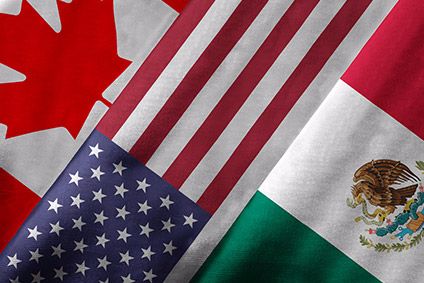
A fully implemented and enforced US-Mexico-Canada Trade Agreement (USMCA) would have a moderate but positive impact on US real gross domestic product and employment after six years, according to a recent report from the US International Trade Commission. But what are the implications for the textile and apparel sector? Dr Sheng Lu, associate professor in the Department of Fashion and Apparel Studies at the University of Delaware, takes a look.
The report – ‘United States-Mexico-Canada Agreement: Likely Impact on the US Economy and Specific Industry Sectors’ – is a necessary precursor to congressional consideration of legislation to implement the USMCA, which would replace the North American Free Trade Agreement (NAFTA).
Impact of USMCA on the US economy
The overall impact of USMCA on the US economy is likely to be moderate. USITC’s economic model suggests that compared to the base year level in 2017, USMCA will only boost US GDP by 0.35% (or $68.2bn) and create 176,000 new jobs. A critical factor behind this modest economic impact is NAFTA – which has substantially cut both tariffs and non-tariff barriers among the three countries.
Impact of USMCA on the textile and apparel sector
First, the USMCA overall is found to be a balanced deal for the textile and apparel sector, particularly regarding rules of origin (RoO). USMCA eases the requirements for duty-free treatment for some products, but tightens the requirements for others. For example, it eliminates the NAFTA requirements that visible linings must be sourced from members of the agreement. However, it adds more restrictive requirements for narrow elastic fabrics, sewing thread, and pocket bag fabric. This is outlined in more detail in an earlier just-style article: NAFTA 2.0 – The devil is in the detail.

US Tariffs are shifting - will you react or anticipate?
Don’t let policy changes catch you off guard. Stay proactive with real-time data and expert analysis.
By GlobalDataSecond, changes to the Tariff Preference Level (TPLs) for non-originating goods appear unlikely to have much effect on related trade flows. As USITC notes, where USMCA would cut the TPL level on certain US imports from Canada or Mexico, the quantitative limit for these product categories was not fully utilised in the past. Meanwhile, the TPL level for product categories typically fully used would remain unchanged under USMCA. The only trade flow that might enjoy a notable increase is US cotton and man-made fibre (MMF) apparel exports to Canada – the TPL is increased to 20m SME annually under USMCA from 9m under NAFTA.
Third, USITC suggests that in aggregate, changes under USMCA for the textile and apparel sector will more or less balance each other out and USMCA will NOT significantly affect the overall utilisation of USMCA’s duty-free provisions. The under-utilisation of free trade agreements (FTA) by US companies in apparel sourcing has been a long-time issue. Data from the Office of Textiles and Apparel (OTEXA) shows that of the total $4,292.8m US apparel imports from the NAFTA region in 2018, only $3,756.1m (or 87.5%) claimed the preferential duty benefits under the agreement. As noted in the latest US Fashion Industry Benchmarking Study, some US fashion companies do not claim the duty savings largely because of the restrictive RoO and the onerous documentation requirements.
Interestingly, however, the USITC report says little about the potential impact of USMCA on US textile and apparel manufacturing.
Next step
The United States agreed the USMCA with Canada and Mexico on 30 September 2018; and the pact was officially signed by the presidents of the three countries on 30 November 2018. According to the Bipartisan Congressional Trade Priorities and Accountability Act of 2015 (TPA-2015), following the release of the USITC economic assessment report, the Trump Administration will need to work with Congress to develop legislation to approve and implement the agreement.
While the US Congress has up to 90 days to discuss and vote on USMCA as required by TPA-2015, there is no specific deadline for introducing the USMCA implementation bill – theoretically meaning this process can take forever. Because of the complicated relationship between the Trump Administration and US Congress as well as other policy issues intertwined with USMCA (such as the section 232 action on steel and aluminum), it remains highly uncertain whether the agreement will be ratified and take effect in 2019 or even 2020.
“The ITC report highlights the importance of the western hemisphere supply chain for apparel and how the USMCA will maintain that relationship. Just as significant, the ITC report is an integral step in the process towards congressional approval of USMCA. We hope the release of the report means that the congressional review process will begin shortly” – Nate Herman, senior vice president of supply chain, American Apparel & Footwear Association (AAFA)
“We agree with the ITC report in terms of general conclusions. The changes to NAFTA re textiles were limited in the end. In some cases improvements were made, and in other areas some nuisance matters were added” – Bob Kirke, executive director, Canadian Apparel Federation
“The USMCA is a win for manufacturers. This agreement will level the playing field for manufacturers in the United States and support the 2m American manufacturing jobs that depend on our exports to Canada and Mexico. That’s why the USMCA is our top trade priority, and we urge Congress to approve it as soon as possible” – Linda Dempsey, vice president of international economic affairs, National Association of Manufacturers (NAM)



